“I don’t need a roof garden,” says Patrick Turcot, executive chef of the historic Hotel Fairmont Le Manoir Richelieu in La Malbaie, a village in the fertile Charlevoix region of Quebec, about 90 minutes east of Quebec City. “Nearby I’ve got produce, veal, poultry, organic pork, duck, foie gras. You’ve heard of the 100-mile diet? Well, I’ve got the 15-mile diet!”
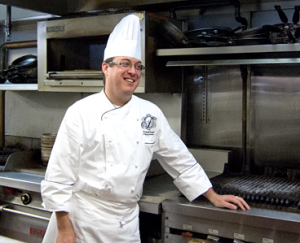
Patrick Turcot, executive chef at Le Manoir Richelieu, is in charge of all of the food items on Le Train du Massif. Photo © Tracey Middlekauff
To illustrate his point, Turcot has prepared a light breakfast featuring local products–basil yogurt flavored with honey from the nearby Charlevoix town Baie-Saint-Paul, a cheese platter featuring cheeses from two local fromageries. He’s chosen a buttery Migneron and a mild sheep’s milk blue from Maison Maurice Dufour, along with a Brie-style Fleurmier and a nutty Hercule cheese from Laiterie Charlevoix.
The Train’s Left the Station
Turcot may be exaggerating a bit about his 15-mile diet, but not by much. His hotel, as well as the producers of most of the ingredients of my breakfast, are part of the Charlevoix Flavor Trail–or La Route des Saveurs–an 89-mile route that winds along the beautiful St. Lawrence River. The trail consists of a collection of farmers, restaurants and producers specializing in local delicacies.
While La Malbaie’s roots as a resort destination go back nearly 200 years, the entire Charlevoix region is poised to become a major culinary destination, thanks largely to Cirque du Soleil co-founder and tourism entrepreneur Daniel Gauthier.
His brand new Train du Massif–which brought me to La Malbaie–began operations running along the cliff-studded coastline of the St. Lawrence River between Quebec City and Charlevoix just this year. As well as making the area more accessible, it’s made the journey itself a huge part of the appeal.
Joie in the Journey
Billed as an adventure in gastronomy, Train du Massif passengers are treated to gourmet multi-course meals during their trip to and from Charlevoix–breakfast, tapas, and/or dinner, depending on the package. The dishes, which feature local products from the Flavor Trail, are prepared ahead of time by Chef Turcot and his team, and finished on board before service. During my journey, I feasted on cinnamon crepes with apples from local orchard “>Ciderie Vergers Pedneault and a miniature asparagus frittata topped with a Swiss style cheese from the nearby Fromagerie St. Fidele.
The train’s first stop is at the station at another new Gauthier project, the Hotel La Ferme in Baie St. Paul, where he got his start busking. On Sundays in May through September, there’s a farmers market right at the station, offering tourists a chance to interact with locals and browse (and taste) the many regional specialties, including oyster mushrooms, smoked salmon, and seasonal produce.
The hotel’s three dining options – the casual Le Café du Marché, the bar/lounge Le Bercail, and the more high-end Les Labours all take advantage of this seasonal cuisine du marche. On my visit, I had a brunch of local beef, farm fresh eggs, and Charlevoix tomatoes, cooked in the bright open air kitchen at the rustic-meets-modern restaurant Les Labours.
La Ferme is a good home base for checking out some of the Flavor Trail producers and taking a tour of the their farms and facilities. Not only is this a great way for visitors to get a sense of the local terroir, it’s fun to compare the different ways chefs use these ingredients on their menus.
Along with cheese, one of the region’s most popular ingredients is foie gras, and it all comes from one small, family-run farm, La Ferme Basque. The free range Muscovy and Pekin ducks here are treated with respect by husband-and-wife farmers Jean-Jaques Etcheberrigaray and Isabelle Mihura, who moved to the region from the Basque country in France nine years ago.
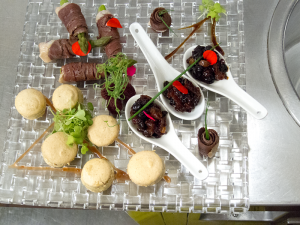
Foie gras macarons, duck-wrapped asparagus and savory chutney in the Fairmont Le Manoir Richelieu kitchen. Photo © Tracey Middlekauff
Foie Gras the Slow Way
La gavage – the much-maligned force feeding which fattens up the duck liver for foie gras – is done by hand here, and only for a short portion of the duck’s life. On my visit, Etcheberrigaray told me that “I wanted to show people that we could do foie gras in a different way. It’s very different from the industrial way of doing things.” Overproduction, Etcheberrigaray explained, causes the liver to be larger, harder, and of a lower quality than his product, which is produced in relatively small quantities. “My goal in life is not to be a billionaire,” he says. “It’s to be happy.”
And local chefs are more than happy to make use of Etcheberrigaray’s excellent duck products in a range of dishes. At Auberge des 3 Canards in La Malbaie, for example, La Ferme Basque’s foie gras appears seared with scallops and served with an emulsion of local Hercule cheese and an apple mistelle sauce from Ciderie Pednault; with house smoked duck; and with grilled Quebec deer and cedar jelly, to name a few dishes. For my dinner at 3 Canards, I had meltingly tender La Ferme Basque duck breast with hot pepper and a fresh mint pesto, as well as an onion soup made with local Dominus Vobisum beer and melted Hercule cheese from Laiterie Charlevoix. And for dessert? A cheese plate, of course.
Elsewhere, I had La Ferme Basque foie gras added to a dish of local veal sausage in gravy at Microbrasserie Le Saint Pub in Baie-Saint-Paul (where I had yet another onion soup with beer, this time topped with melted Migneron cheese from Maison Maurice duFour); in a crunchy green salad at the restaurant at the cozy inn L’Estampilles, also in Baie-Saint-Paul; and, in a most unusual preparation at Le Manoir Richelieu, where Chef Turcot prepared a treat of savory foie gras macarons. Perfectly crispy on the outside, the shell gave way to a surprising burst of rich, whipped, livery foie gras mousse.
Sadly, in my three short days in Charlevoix it was not possible to visit all of the nearly 40 producers and restaurants which make up the Flavor Trail. This, of course, is the perfect reason to return – likely along with an ever-increasing number of tourists thanks to the Train du Massif. I asked Chef Turcot how he felt about the secret of Charlevoix reaching the outside world.
“Obviously the more we talk about it, the more the secret will go away,” he said. “But we are always excited to have tourists discover our beautiful region. … After living outside of Quebec for the past 10 years and coming back in this magnificent region, I quickly realized that we are blessed with beauty, terroir, and art which is the best composition of happiness.”
For two recipes from Chef Turcot, go to our Recipes page. (You may have to scroll a bit.)

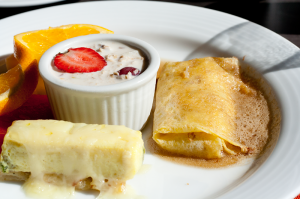
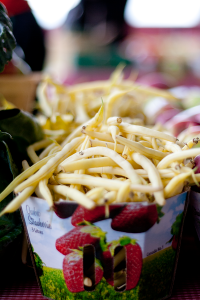
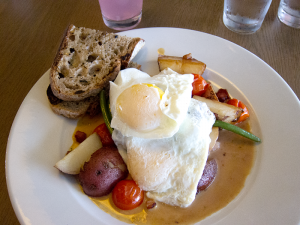
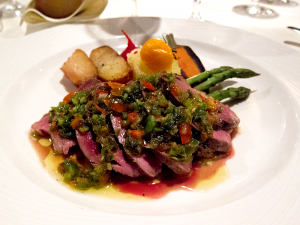
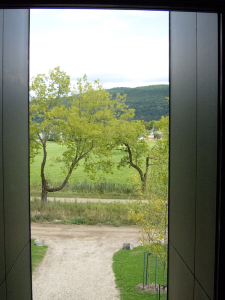
Charlesvoix: A New-Old Food Paradise: “I don’t need a roof garden,” says Patrick Turcot, executive… http://t.co/X241BR2x via @toquemag